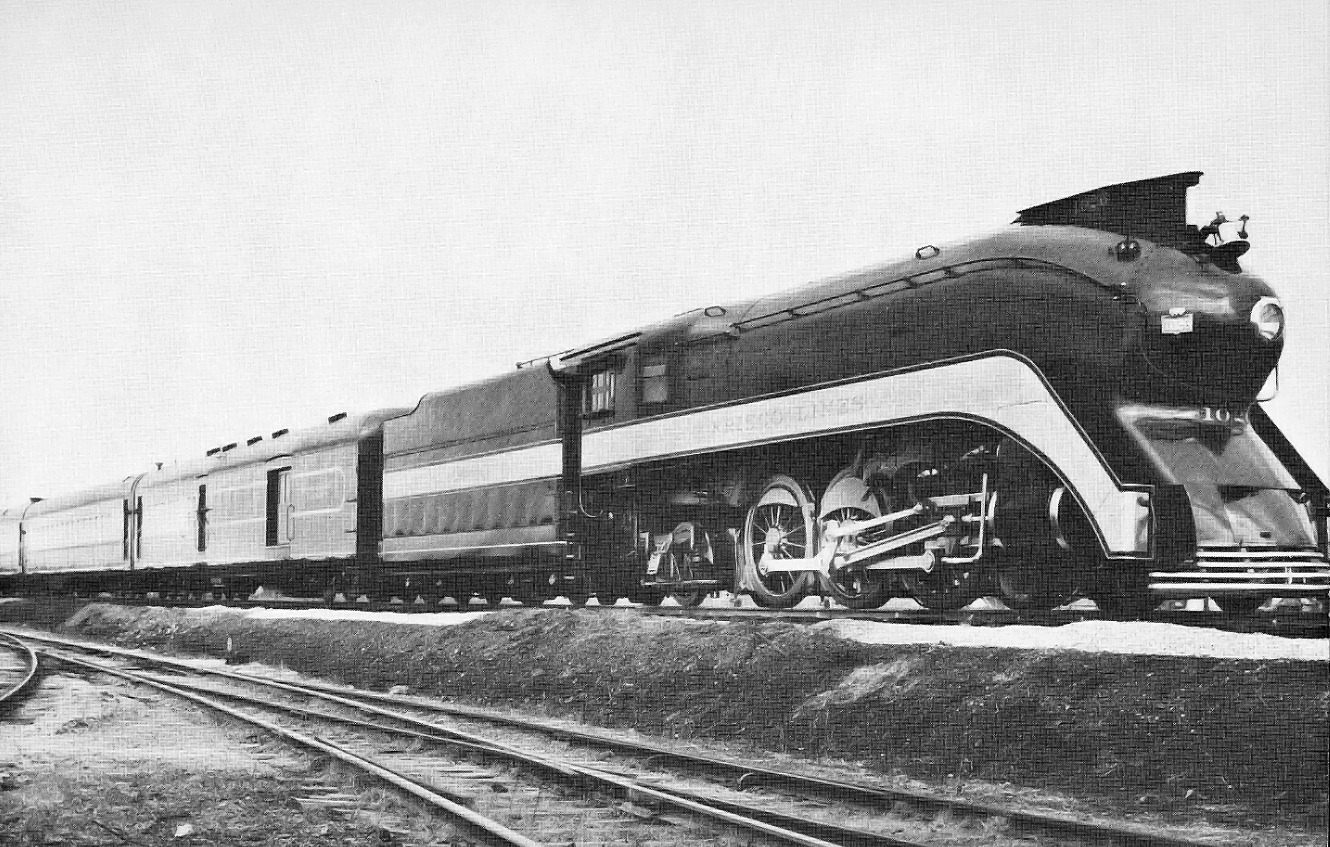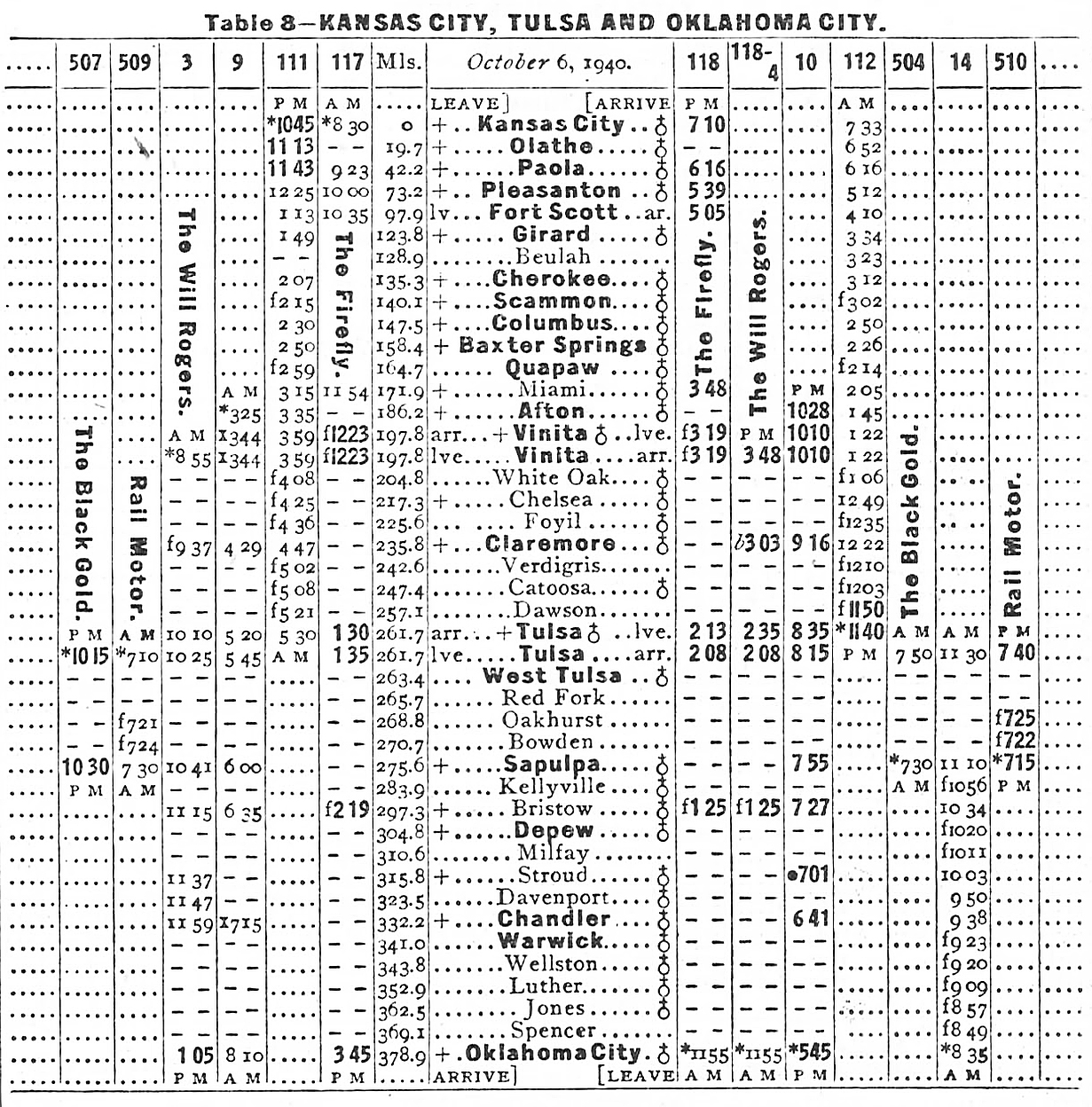- Home ›
- Fallen Flags ›
- Frisco ›
- The Firefly
Frisco's "Firefly" (Train): Consist, Route, Timetable
Last revised: February 24, 2025
By: Adam Burns
The Firefly was a distinguished streamlined passenger train operated by the St. Louis – San Francisco Railway. During its time in service the Firefly connected key destinations, including St. Louis, Missouri; Tulsa and Oklahoma City, Oklahoma; Kansas City, Missouri, and Fort Scott, Kansas.
Generally, the train operated 262 miles from Kansas City and Tulsa with intentions of competing against the Santa Fe's streamlined Chicagoan/Kansas Cityan.
It embarked on its inaugural journey on March 29, 1940, and continued to serve passengers until May 22, 1960.
As the Frisco Railway’s first streamliner and the pioneering streamliner built in the southwest, the Firefly holds a special place in the history of American rail travel.
History
In its haste to get these trains into service, George Drury notes in his book, "Guide To North American Steam Locomotives," the Firefly originally commenced operation as a non-streamlined train on December 10, 1939.
It was later reinaugurated as a streamliner on March 29, 1940, along the Kansas City—Tulsa—Oklahoma City route running a distance of 379 miles. This service was introduced to compete with the Santa Fe Railway's expanded diesel streamliner,
The Chicagoan/Kansas Cityan/Tulsan, which also served Tulsa and Oklahoma City. Despite relying on older steam locomotives, the Firefly maintained competitive travel times, completing the journey to Tulsa in 5 hours and 5 minutes and to Oklahoma City in 7 hours and 15 minutes.
The Frisco offered convenient daylight service, while the Santa Fe, running through-service to and from Chicago (a city not served by Frisco), scheduled arrivals and departures from Oklahoma City during the early morning hours.
Locomotives and Consist
The Frisco decided to enhance the aesthetics and performance of its steam locomotives by fitting them with a sleek, torpedo-type cowling that gave the appearance of a bullet racing down the track.
It took three locomotives, originally built by Baldwin in 1910, and rebuilt the engines at the Springfield Shops.
The first was #1026 completed in November, 1939. Subsequently, two other 4-6-2s, #1018 and #1031, were also converted for use in the Firefly service.
Numerous enhancements were applied to these locomotives, which already featured smaller cylinders and higher boiler pressure. Notable improvements included taller drivers, an oil-burning firebox, a larger tender, and significantly increased weight on both the drivers and overall locomotive.
Locomotives 1018 and 1031 were equipped with Walschaert valve gear, while No. 1026 had Baker valve gear.
The streamlined casing that enveloped the boiler boasted a bullet nose, a faired stack, and a thick valence over the exposed running gear.
A broad band of color adorned the valence and the tender, simply inscribed with "Frisco Lines." As rail historian George H. Drury noted, “Streamlined or not, the bell and the whistle were out front where they could be heard.”
Based on photographic evidence, the trio of locomotives retained their streamlined shrouds for the remainder of their service lives.
Locomotive No. 1026 was the first to be retired from service on May 31, 1949. No. 1031 followed on October 4, 1949, while No. 1018 continued in operation until May 22, 1950.
Consist (1940)
To enhance speed, the driving wheels of these locomotives were enlarged from 69 inches to 73 inches using extra-thick driver tires.
Frisco also undertook the refurbishment of its passenger cars, eventually assembling a fleet of eighty-nine cars, all painted in the matching blue and gray livery.
Two separate consists were required to maintain the Firefly's schedule. Each consist comprised refurbished heavyweight cars, including a baggage-mail coach with 16 seats, a coach with 60 seats, and a café-parlor car.
In later years, the Firefly was powered by various E8A locomotives named after racehorses or FP7 locomotives, continuing the tradition of innovation and excellence in rail travel.
Timetable (March, 1940)
Final Years
The Firefly's popularity quickly exceeded the capacity of its original three-car consist, often necessitating the use of mismatched conventional cars to accommodate the surge of passengers during World War II.
In the 1950s, the train's route was shortened to Kansas City-Tulsa. The Firefly made its final run on May 22, 1960, operating between Fort Scott and Tulsa; on the segment between Fort Scott and Kansas City, it ran in combination with the Sunnyland. The train's end marked the conclusion of Frisco's passenger service on the Tulsa-Fort Scott route.
Recent Articles
-
Tennessee Christmas Train Rides In Knoxville!
Dec 08, 25 12:19 PM
While the Three Rivers Rambler hosts a variety of seasonal excursions throughout the year, its most anticipated annual tradition is the Christmas Lantern Express. -
Pennsylvania Christmas Train Rides In Middletown!
Dec 08, 25 12:10 PM
In central Pennsylvania, the Middletown & Hummelstown Railroad captures that spirit every year with its seasonal Christmas trains, notably Santa’s Surprise Train and the Polar Bear Express. -
Kankakee Belt Route, NYC's Illinois Division
Dec 08, 25 12:25 AM
The Kankakee Belt Route was one of the Midwest’s most interesting “quiet” main lines—a strategic bypass around Chicago that never became a famous name in its own right.






